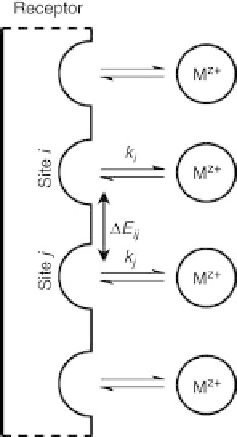Chemistry Reference
In-Depth Information
Figure 3.14 Site-binding model for polynuclear complexes with a linear receptor R.
The application of the site-binding model is straightforward for mono-stranded heli-
cates, where the ligand behaves as a linear receptor
R
for successively fixing metallic
cations [39,47]. However, the extension of the model to double- and triple-stranded heli-
cates requires the consideration of a virtual receptor preorganized from the ligands form-
ing the supramolecular edifice. The metal binding to
R
thus occurs in an intermolecular
fashion. This dissection of self-assembly processes for dinuclear triple-stranded helicates
is graphically illustrated in Figure 3.15 together with the associated site-binding model
for each species [48]. Although D
G
preorg
is difficult to access, it similarly influences all
complexes related to the same receptor. This translation of the zero-level of the free
energy of formation can be arbitrarily set to D
G
preorg
¼
0. Consequently, in the case of a
ditopic preorganized receptor (Figure 3.15), the binding equilibria are defined with the
stability constants
2
,where
k
N
6
O
3
is the micro-
scopic affinity for the binding site, that is, N
6
O
3
. To extract reliable values of
k
N
6
O
3
and
u
M;M
M;R
1
2
k
N
6
O
3
M;R
2
k
N
6
O
3
Þ
2
u
M;M
1
b
¼
and
b
¼ð
;
1
;
1
1-2
, a sufficient number of experimental stability constants should be available. Alterna-
tively, the thermodynamic stability constants for closely related receptors can be simulta-
neously considered. In this context, the site-binding model was elegantly applied for the
analysis of homo- and heteronuclear complexes, and the fitted binding affinities allowed
establishing the trends in relative affinities of metal ions along the series [48]. Moreover,
the analysed data systematically show repulsive intermetallic interactions (D
E
M;M
12
0,
negative cooperativity). In addition to this example, the site-binding model was success-
fully adapted for trinuclear triple-stranded helicates possessing two different coordination
sites [44,48].
Despite limiting hypotheses concerning the preorganized receptor, the site-binding
model is particularly suitable for the rationalization of metal exchange processes and rela-
tive trends in the series of similar complexes. Moreover, its use is fully adequate for the
>

Search WWH ::

Custom Search